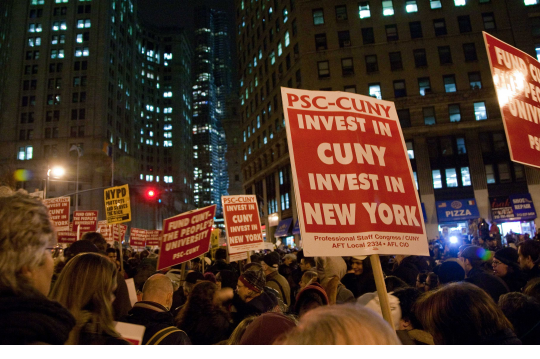 |
On December 8, New York’s Legislature gave its approval to a package of changes in the state’s income tax structure. Based on a proposal by Gov. Andrew Cuomo, the tax plan adds new brackets to basic tax rates at the higher end of the scale and cuts rates for many at middle and lower incomes.
But the vote also signaled that the existing surcharge on the state’s highest-income residents, known as the “millionaires’ tax,” would be allowed to expire on December 31 – which means that wealthy New Yorkers will get a net tax reduction, and the State will lose a major source of revenue.
THE NUMBERS
The failure to renew the millionaires’ tax means a loss of $4.6 billion in revenue, while the new tax changes will bring in $1.9 billion in new funds. The new tax structure will be more progressive than if the millionaires’ tax had simply been allowed to expire – but gives the largest reductions to those earning between $500,000 and $2 million a year.
Other parts of the plan reduce the MTA payroll tax, which helps fund mass transit, and provide special flood relief upstate. After these deductions, $1.55 billion will remain for reducing the projected $3.5 billion in next year’s budget, leaving a $2 billion hole to fill.
A SHIFT
“Albany has moved on taxes – after months of intense political protest – but has not moved far enough,” said PSC President Barbara Bowen. While the plan “represents a significant shift in Albany’s approach,” she said, “it does not produce enough revenue” and “does not eliminate the injustices in our tax structure.”
“There is nothing fair about making some of the poorest families in the state pay CUNY’s 30% tuition increase when the richest families are still getting a tax break,” argued Bowen.
For Cuomo, the plan marked a sharp turn in language and an adjustment on policy. Since his election, the governor had insisted that the millionaires’ tax must end, and that retaining it would in effect be a tax increase. His main talking point, frequently repeated, was that keeping the tax would cause the rich to leave New York. Existing studies show that this is not the case, but Cuomo gave no ground.
By November, the governor had changed his tone. “Fairness in the tax code is a very important issue,” he told a group of Latino legislators. In December, when the tax plan was announced, Cuomo declared, “We do need additional revenue.” While he still wants to reduce New York taxes in the long run, Cuomo said, “If I were to close the entire gap by budget cuts, it would decimate essential services.”
Why the change? Observers across the state credited the Occupy Wall Street movement and the political debate it sparked. “The protesters have attacked Cuomo and coined a sticky new monicker: Governor One Percent,” wrote Albany Times-Union reporter Jimmy Vielkind. Cuomo, who has cultivated support from corporate groups like the Committee to Save New York, is anxious to shed that label.
Vielkind also credited union community groups like Strong Economy for All, which organized people “to knock on doors around the state” this fall, asking constituents to pressure key legislators to back increased taxes on the rich.
INEQUALITIES
“PSC members and CUNY students have been exceptionally active in demanding fair taxation,” commented Bowen. She pointed to “the union’s peaceful direct action for progressive taxation last spring, which resulted in 33 arrests outside the door of the governor’s office”; the PSC’s role as the first union to back Occupy Wall Street; and “the sustained work by coalitions of which the PSC is proud to be a part,” including Strong Economy for All, 99% New York, and the Working Families Party (WFP).
But while the tax package was a change in direction for Albany, labor and community advocates agreed with the PSC that it falls far short of what is needed. Bowen pointed out that the plan’s $2 billion in lost revenue, compared to a renewal of the millionaires’ tax, is roughly equal to the projected State deficit for the next fiscal year.
The New Deal for New York Campaign pointed out that, compared to rates in 2011, the new tax structure will give the biggest tax break to those with incomes between $500,000 and $2 million a year. “A family making $50,000 a year will get less than $200 a year in tax cuts,” it noted, while “a family making $1 million a year gets more than $20,000 in tax cuts – or $408 per week.” The highest bracket is set to expire in 2014, leading to another tax break for the rich unless it is extended.
REFORM PUSH CONTINUES
With the debate over next year’s budget about to kick off in January, fair-tax advocates across the state are planning their next moves. “If Albany’s tax deal is a first step,” said Bowen, the Fiscal Policy Institute’s 1% Tax Plan offers a good map of where our next steps should take us.” FPI’s plan would raise up to $5 billion a year by raising marginal tax rates on taxpayers with annual incomes above $665,000 – roughly the top 1%.
Strong Economy for All and the WFP have vowed to go after corporate tax loopholes; they say that closing these could add up to billions in badly needed revenue for public services.
“The movement for progressive tax reform is far from over,” said Bowen. “With a huge budget deficit looming,” she continued, “we can’t allow…the opportunity for a more ambitious reform to be lost. What’s at stake for the PSC is whether our classrooms will continue to be so crowded that students sit on windowsills, whether CUNY faculty will have resources for research, whether students who have dared to dream of a better life will have a chance to succeed.”

